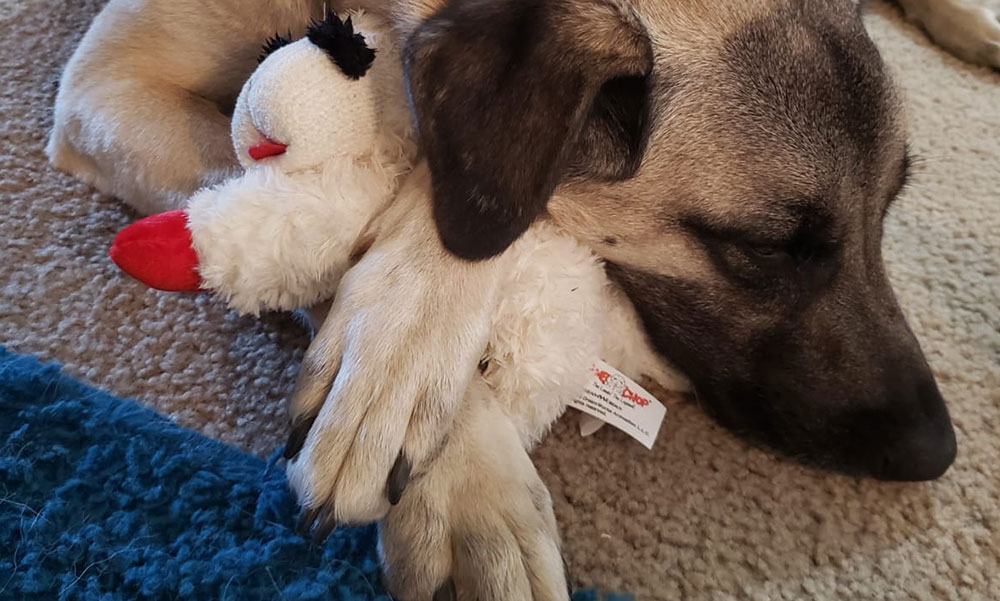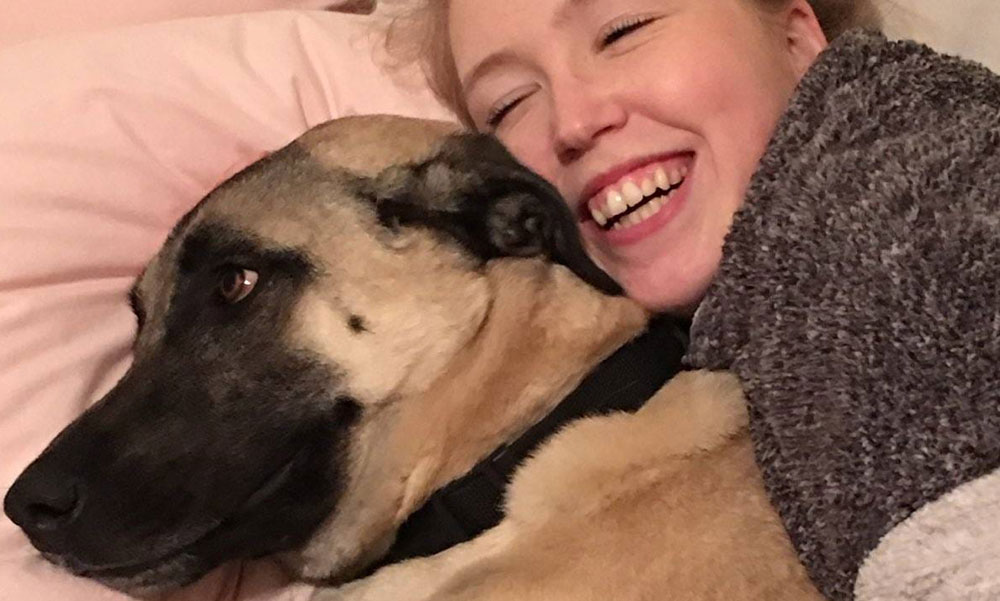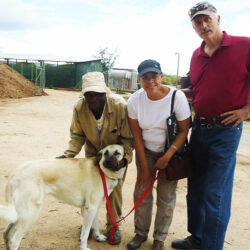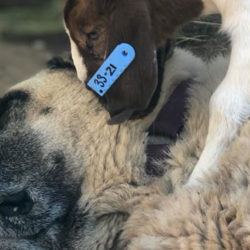From Farm to Family: Nellie’s Journey
-

- by Megan Barnes March 13, 2020

Megan was a CCF intern a year ago. When she was with us she helped with a dog that did not do well as a working Livestock Guarding Dog (LGD) (a rare occurrence). Megan decided to take her with her back to the US as her pet and protector. March is the anniversary of Nellie’s adoption.
CCF has placed a couple of dogs in the USA over the years and it is a huge commitment for a family to undertake.
– Dr. Laurie Marker


The typical life cycle of a Livestock Guarding Dog goes more or less as follows:
- They are born in the late hours of the night, under a blanket of stars as staff spends a sleepless night checking to make sure everything is okay.
- They spend the first three weeks of life learning to walk and yowl, hungry for milk and exploration; often using the only tool at their disposal to understand the world around them – their teeth. During my time at the Cheetah Conservation Fund (CCF), I have encountered probably thousands of needle-like nibbles from curious puppies.
- Starting at four weeks of age, goats are put in their run pens, serving as roommates they will soon see as their own kind. In this developmental time period where most pet dogs, as we know bond to humans, future livestock guarding dogs create an exceptional bond with these hoof stock animals. This devotion and unfaltering loyalty are what allow a Livestock Guarding Dog to do their job so well. Instead of looking to people for encouragement or praise, they look to these goats!
- In the following weeks they will make an unspoken vow to protect them, whatever the cost. Sometimes, I think these dogs believe they are just ‘smart’goats, or maybe they think these goats are actually dogs; I often wonder what an Anatolian Shepherd sees in its reflection.
- After a mere 10 weeks of learning the essential motor skills of a dog and honing in the strategy of how to protect livestock through rough play with their siblings, these pups are sent to their new homes in Namibia spanning across distant lands.
It is at these farms where their life truly begins, and where their purpose is brought to fruition. These young warriors have no idea what lies ahead of them on that drive to their destiny, but in that strange way that dogs just seem to know things, these puppies know that this is what they were born to do.
The story of Nellie
July 2nd, 2017 held the same beginning for all Anatolian Shepherd and Kangals at the CCF do, a litter of puppies were born under the Namibian night sky. They spent those first few weeks growing and learning, at four weeks they met their roommate that they would soon love more than anything in this world, and at around 10 weeks they were all transported to their new farms where they would live out their lives protecting livestock. One puppy from this particular litter, Nellie, however, knew in the strange way that this would not be the life for her. The thought of exploration struck a fear in her that did not plague her siblings. The life that was ancestrally planned for her breed did not call to her. Though she did try her very best, after a little over a year at her farm she returned to CCF.
Upon her return, this young Anatolian Shepherd was then named (Nervous) Nellie. I arrived shortly after, and had been adopted by the Livestock Guarding Dog Program, so I was fortunate enough to be tasked with training and preparing Nellie for the world of pet-hood. When I met her, Nellie did not know any commands (granted, working dogs do not really need to know these things), would let out a nervous pee every time I approached her enclosure, and she had to stay in a clinic enclosure with a lock on it because she kept escaping. She could not walk on a leash; she would take a few steps and then her fear would cause her to freeze. The staff and I realized her greatest obstacle was actually quite simple, a lack of confidence. If we could build her confidence, she could grow into the dog she was always meant to be, whether or not that dog was out protecting livestock.

In the following ten weeks I interned at CCF, I worked with Nellie every day; and slowly she became a different dog. She went from not being able to walk 100 feet without freezing, to being able to go on full length walks that lasted 30 minutes or longer. She started learning commands like sit and lay down, she started to play! She stopped peeing when I approached her enclosure, even her posture changed. There were leaps and bounds of progress just within those two and a half months, and when I left CCF, I decided that Nellie would join me in the United States shortly after, CCF agreed. We are coming up on a year of Nellie’s transition from a working life in Namibia to pet life in the United States, and it has been a remarkable challenge and journey for the both of us.
I’m sure in the beginning, Nellie felt nothing short of being abducted by aliens, transported to this entirely different world of concrete and noise, as when I first got her, I lived in a college town in Oregon. She struggled with street lights and cross walks and refused to go outside at night. She had trouble with getting in the car to go to the vet, and even walking through doors. Slowly, as we did at the CCF, Nellie and I worked on walking outside in an entirely new environment. We worked on how to handle seeing other dogs across the street, not to be afraid of people in hats walking past her. And what on earth a bicycle was and that it was okay for her to pass one. After the first few months, Nellie learned how to handle these different things and she could go on walks again! To this day however, Nellie still does not like pizza delivery cars, I’m not sure what prejudice she has towards them but the magnet on top of those cars just upsets her.
On top of adjusting to a new physical world around her that smelled different, looked different, and especially sounded different, Nellie also had to adjust to living inside a home. Or rather, an apartment, at first. Before now, Nellie had lived in a clinic or out on a farm, so she had never seen a kitchen before, she didn’t know what a couch was or a refrigerator. She had to learn all about how to live inside, which also took a long time to adjust to. She experienced some intense separation anxiety whenever I left to go to class or have lunch with a friend. I would come home to find oranges spread over my floor, holes in the carpet, fallen lamps, and every single left shoe I owned out in the living room. It was always the left shoe. This however, eventually faded with time and preparation. Anything shoulder level and down, Nellie could reach, so all important items went on tall bookshelves, in a cupboard (which Nellie eventually learned how to open) and I started closing my bedroom door whenever I left to spare my pillows and left shoes. After around 7 months, and after I moved into a bigger house with more space, Nellie calmed down. I can happily say now that when I come home from work, there is very rarely a mess from her getting into something she’s not supposed to.


Nellie, like most dogs, loves to play; but again, she had to learn how to play and something I did not expect to go through was teaching her what a toy was. Or, more appropriately, what a toy wasn’t. Nellie got her first traditional toy in Namibia, it was a tri colored rope toy and I remember when Stella (CCF’s LGD Programme Assistant Manager) and I gave it to her; she lit up, throwing it around and completely biting through the middle of it so she had two rope balls instead of one singular rope toy. But now, in this apartment with all of these new things, she could play with everything! After she started to settle in, she got very curious about the objects around her, and with teeth being the only tool at her disposal to explore, she could be a bit destructive at times.
She went through a 3-month pillow phase, where the only thing she wanted to play with were my pillows. Tirelessly I redirected, scolded, tucked away pillows into my closet to find her nosing around and trying to snatch one without me seeing. Eventually, with a lot of time and consistent redirection, she understood that pillows are not in fact toys, and again another lesson learned and Nellie coming to terms with the boundaries of her new life. One cure of her boredom and a distraction in the relentless search for pillows during this time was teaching Nellie new commands. It amazes me still at how quickly she picked up tricks, so long as she was giving me her full attention. She can now roll over, shake with both paws, play dead (which she learned in one day and I think it’s personally her favorite), and most recently, how to balance a treat on her nose. However, the concept of no is a continuous work in progress.
There have been a few wild card incidents with Nellie which I thought I would include as well just because these random incidents are part of the everyday challenges of being a pet owner. One night in June at around 4 a.m. I woke up to find Nellie just standing on my kitchen table. I’m not sure what she was trying to reach or what was going through her mind but when I caught her I swear she had the exact same look on her face as I did when I was caught sneaking chocolate chips out of the pantry as a child. She’s eaten and passed half of a tennis ball, knocked the rear view mirror clean off of my windshield, and completely chewed through a door knob to get out of a bathroom she locked herself in while I was at dinner with my dad. These are just a few moments of the randomness of pet-hood that I have had to embrace, they are entertaining in hindsight, though at times frustrating in the moment.
Nellie and I are still working on a few things, as there is always progress to be made. We still struggle with her getting really excited when she meets other dogs on walks, and that can come across intimidating for a large dog like her. We are still working on being confident while going to the vet and stepping on the scale by herself (hoping to accomplish that soon!), and learning to take baths. I have never had so much trouble giving a dog a bath, and it is strictly a two-man operation now, after my first attempt to give her a bath by myself failed horribly. However, from my experience at CCF, this hatred of water seems universal for all Anatolian Shepherds as I have given multiple livestock guarding dogs baths and not one received it well.
Nellie has overcome drastic changes in her life. Changes that I think a lot of people can probably relate to. She moved to a different country without any knowledge of how to survive in it. She has very prominent anxiety that she has had to find appropriate coping mechanisms for, and large obstacles that she has had to face (and not just the bicycles). She truly has come so far in the last year of us becoming a little family of two, and I know that the future will only bring more progress and she will continue to speak for her breed over here in the United States. There are still a lot of things left on the list to check off for Nellie and I but we are looking forward to the work.

Related Reading
-
October 3, 2022
Eulogy for Aleya – CCF’s Stubborn Sweetheart -
April 8, 2022
Puppy Delivery Journey with Gebhardt




